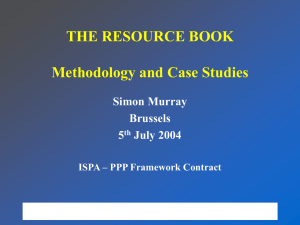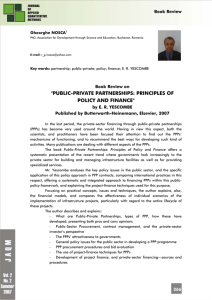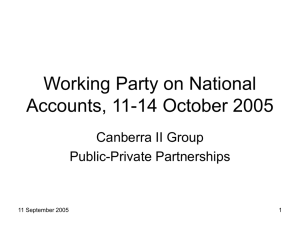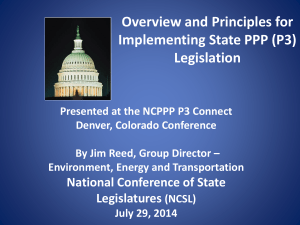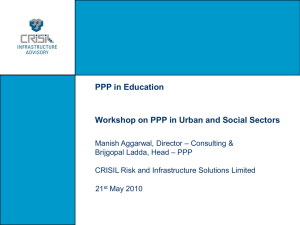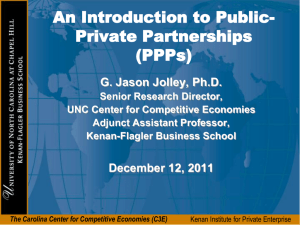Public-Private Partnerships for Transportation: A Toolkit for Legislators
advertisement
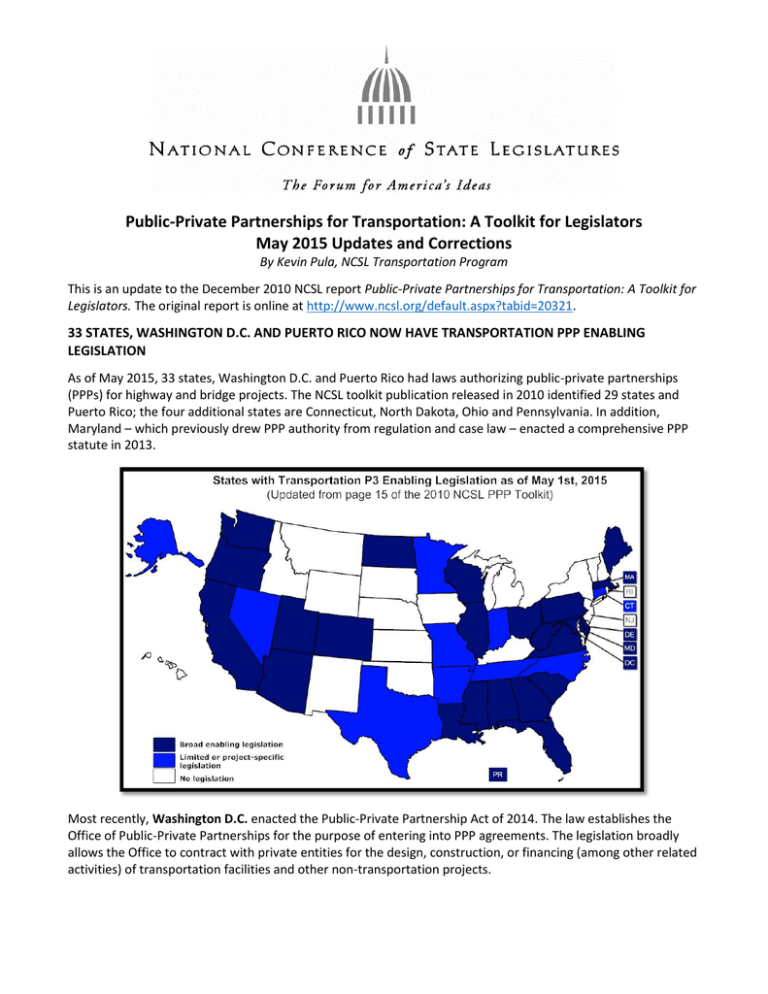
Public-Private Partnerships for Transportation: A Toolkit for Legislators May 2015 Updates and Corrections By Kevin Pula, NCSL Transportation Program This is an update to the December 2010 NCSL report Public-Private Partnerships for Transportation: A Toolkit for Legislators. The original report is online at http://www.ncsl.org/default.aspx?tabid=20321. 33 STATES, WASHINGTON D.C. AND PUERTO RICO NOW HAVE TRANSPORTATION PPP ENABLING LEGISLATION As of May 2015, 33 states, Washington D.C. and Puerto Rico had laws authorizing public-private partnerships (PPPs) for highway and bridge projects. The NCSL toolkit publication released in 2010 identified 29 states and Puerto Rico; the four additional states are Connecticut, North Dakota, Ohio and Pennsylvania. In addition, Maryland – which previously drew PPP authority from regulation and case law – enacted a comprehensive PPP statute in 2013. Most recently, Washington D.C. enacted the Public-Private Partnership Act of 2014. The law establishes the Office of Public-Private Partnerships for the purpose of entering into PPP agreements. The legislation broadly allows the Office to contract with private entities for the design, construction, or financing (among other related activities) of transportation facilities and other non-transportation projects. Connecticut enacted new PPP enabling legislation in October 2011 (HB 6801b / 2011 Conn. Acts, P.A. 11- 01). The law authorizes PPPs for the design, development, operation or maintenance of revenue- generating facilities across diverse sectors, including transportation systems such as ports, transit- oriented development and related infrastructure. It limits this PPP authority, however, to up to five projects before Jan. 1, 2015, and requires the legislature to approve tolls on highways in the state. Until 2013, Maryland did not have a statute expressly authorizing transportation PPPs. The state, however, had established a PPP program via regulation and case law—a situation that was implicitly acknowledged in state statute through PPP oversight provisions. Maryland House Bill 560 (2013 Md. Laws, Chap. 5), enacted on April 9, 2013, established comprehensive state policy on transportation PPPs. North Dakota’s law (N.D. Cent. Code §§48-02.1-01 et seq.), enacted in 1993, allows private operators to construct, improve, rehabilitate, own, lease, manage and operate fee-based facilities. Transportation projects are not identified explicitly, but information received since 2010 indicates that the statute was also meant to apply to fee-based transportation facilities and has been used for a toll bridge.1 Ohio’s PPP enabling legislation (2011 Ohio Laws, House Bill 114), enacted in March 2011, broadly authorizes the state department of transportation (DOT) to enter into PPPs based on solicited or unsolicited proposals from private entities. It also makes permanent the DOT’s authority to enter into design-build agreements. In 2013, however, House Bill 51 adjusted and repealed some of this authority. Pennsylvania’s PPP enabling statute for roads and bridges (House Bill 3 / Act No. 2012-88) was signed into law in July 2012. The law allows state or local public entities to enter into PPPs for the design, construction, operation, maintenance, financing or lease of transportation facilities. All partnerships must be approved by a PublicPrivate Transportation Partnerships Board. The bill also allows the legislature to block PPPs for state-owned facilities and requires legislative approval for PPPs on the Pennsylvania Turnpike. TRANSPORTATION PPP BILLS CONSIDERED IN STATE LEGISLATURES SINCE 2010 At least 37 states considered 158 PPP-related bills from 2011 to 2013; at least 22 states considered 71 relevant bills in 2014; and at least 21 states considered 41 relevant bills in 2015. Many bills enacted during these sessions besides those listed above made amendments to existing PPP statutes. See NCSL’s Transportation Funding and Finance Legislation Database at http://www.ncsl.org/default.aspx?tabid=25720 for more details. CORRECTION TO PAGE 17 (PRINTED VERSION ONLY) The map on page 17 of the printed report incorrectly shows New Mexico as having PPP legislation with no formal legislative requirements. Arizona should be shown as having PPP legislation with no formal legislative requirements; New Mexico has no PPP law. (This was corrected in the online PDF; link below.) ADDITIONAL NCSL RESOURCES For more information about state policy for transportation PPPs, see these online NCSL resources: NCSL Online Transportation Funding and Finance Legislation Database (regularly updated): http://www.ncsl.org/default.aspx?tabid=25720 Public-Private Partnerships for Transportation: A Toolkit for Legislators online: http://www.ncsl.org/default.aspx?tabid=20321 NCSL Foundation Partners Project on PPPs for Transportation (2008 to 2011): http://www.ncsl.org/default.aspx?tabid=17528 1 Jay Lindgren, Dorsey & Whitney LLP, e-mail to author, April 12, 2011.
